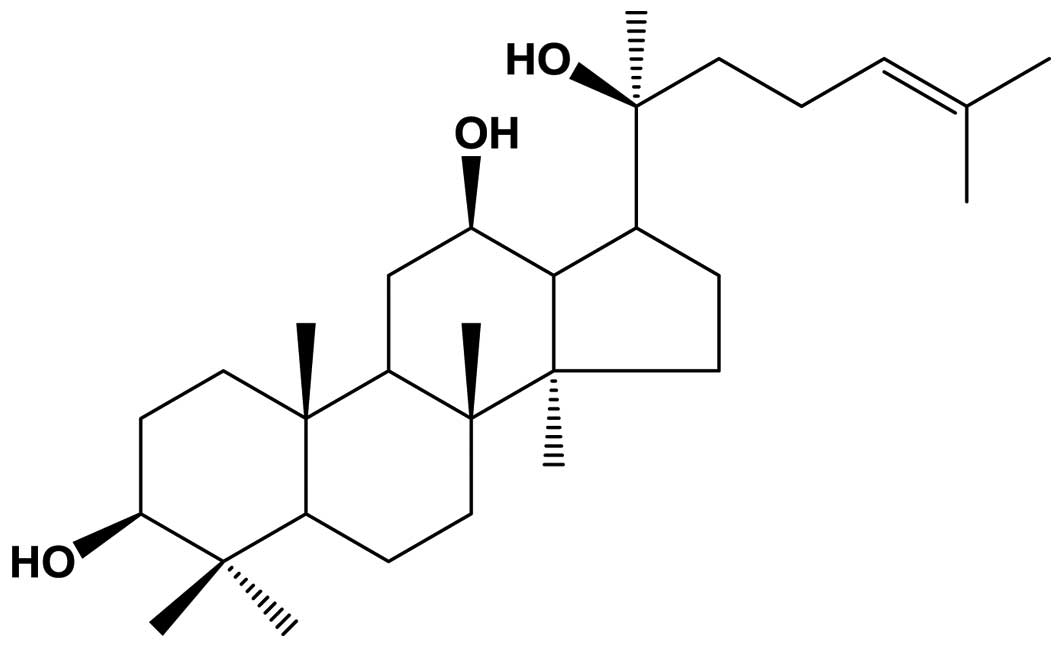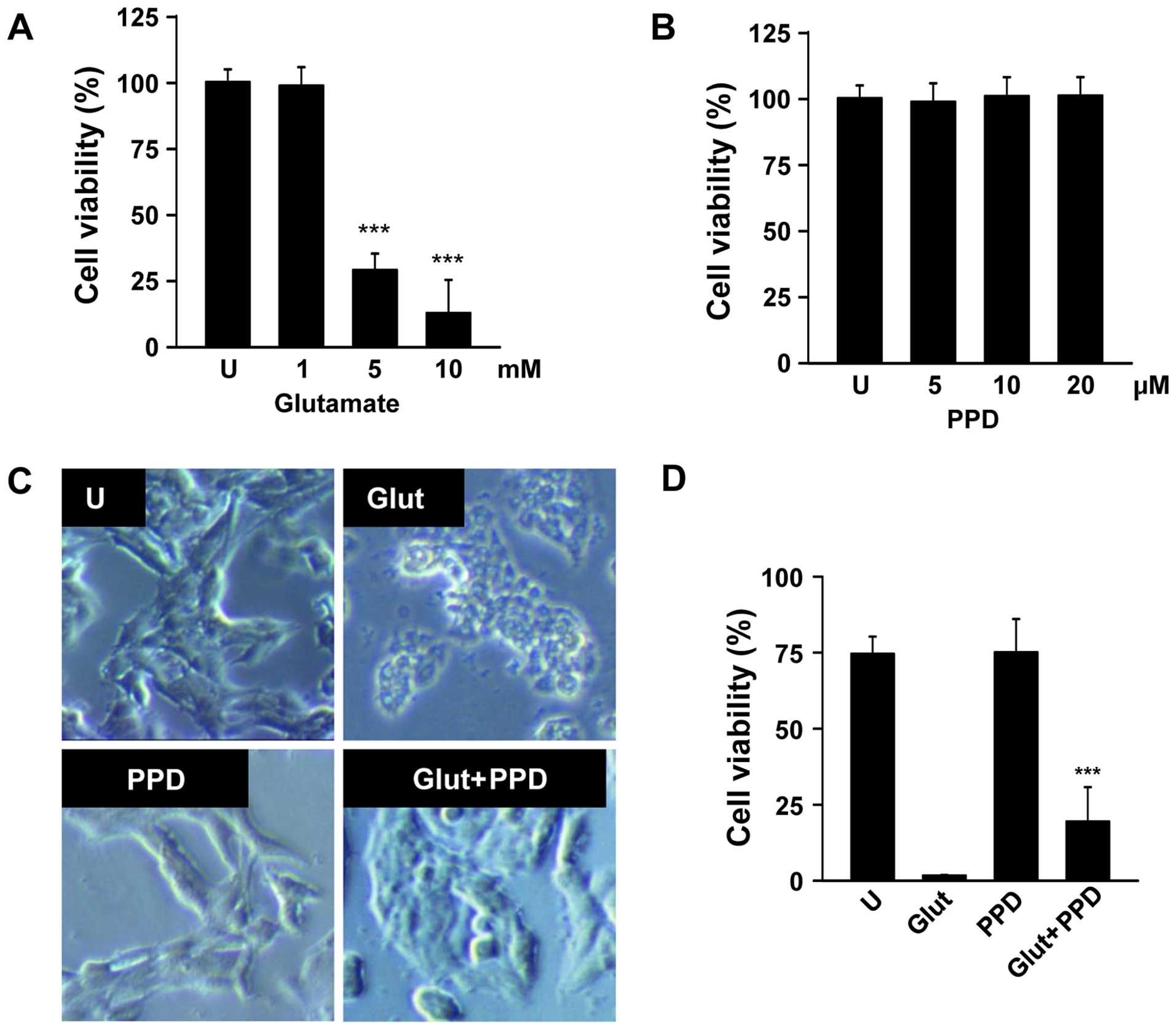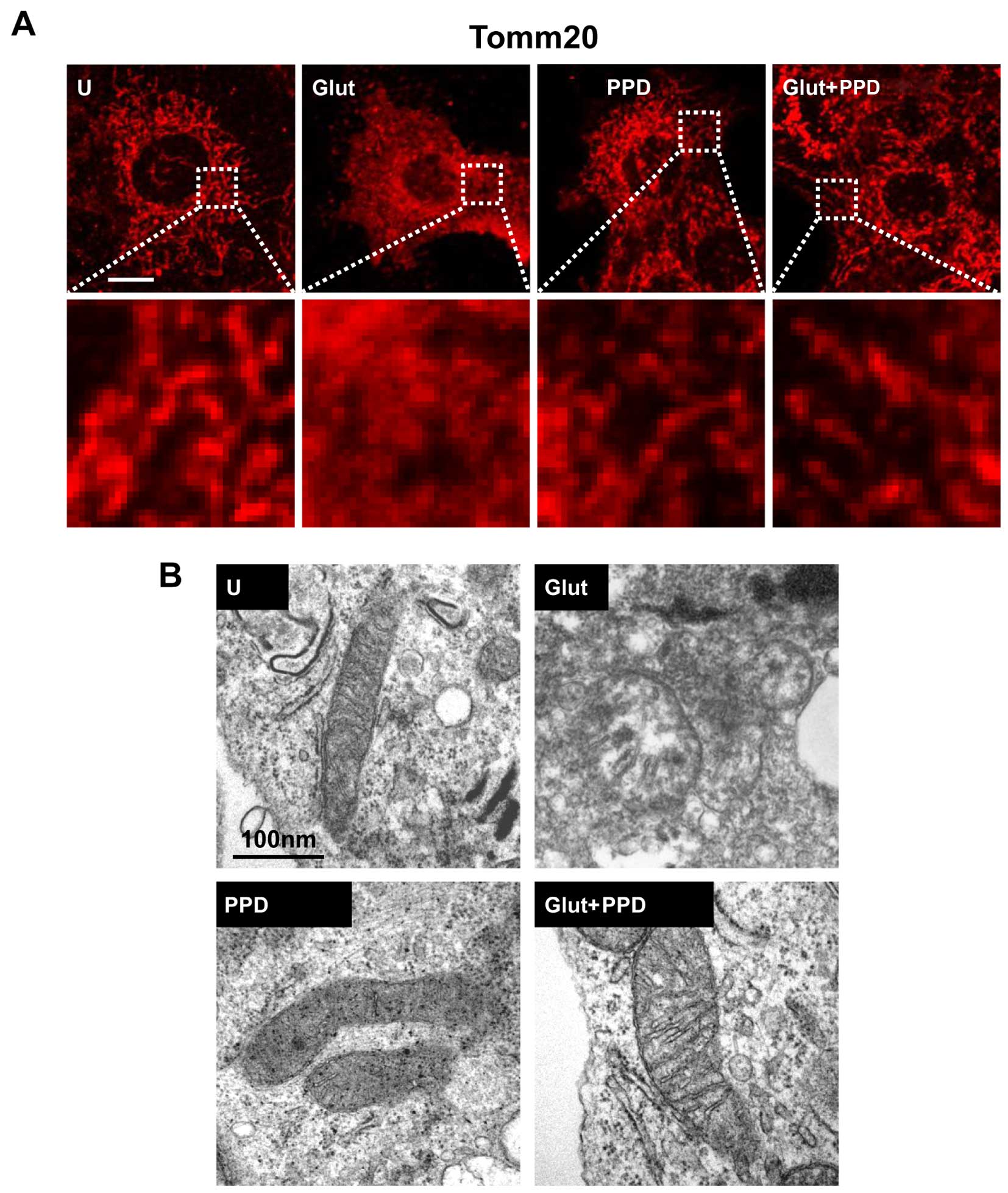|
1
|
Liu CX and Xiao PG: Recent advances on
ginseng research in China. J Ethnopharmacol. 36:27–38. 1992.
View Article : Google Scholar : PubMed/NCBI
|
|
2
|
Nah SY, Kim DH and Rhim H: Ginsenosides:
are any of them candidates for drugs acting on the central nervous
system? CNS Drug Rev. 13:381–404. 2007.PubMed/NCBI
|
|
3
|
Benishin CG: Actions of ginsenoside Rb1 on
choline uptake in central cholinergic nerve endings. Neurochem Int.
21:1–5. 1992. View Article : Google Scholar : PubMed/NCBI
|
|
4
|
Benishin CG, Lee R, Wang LC and Liu HJ:
Effects of ginsenoside Rb1 on central cholinergic metabolism.
Pharmacology. 42:223–229. 1991. View Article : Google Scholar : PubMed/NCBI
|
|
5
|
Kim S, Ahn K, Oh TH, Nah SY and Rhim H:
Inhibitory effect of ginsenosides on NMDA receptor-mediated signals
in rat hippocampal neurons. Biochem Biophys Res Commun.
296:247–254. 2002. View Article : Google Scholar : PubMed/NCBI
|
|
6
|
Zhang C, Du F, Shi M, Ye R, Cheng H, Han
J, Ma L, Cao R, Rao Z and Zhao G: Ginsenoside Rd protects neurons
against glutamate-induced excitotoxicity by inhibiting Ca(2+)
influx. Cell Mol Neurobiol. 32:121–128. 2012. View Article : Google Scholar
|
|
7
|
Ye R, Han J, Kong X, Zhao L, Cao R, Rao Z
and Zhao G: Protective effects of ginsenoside Rd on PC12 cells
against hydrogen peroxide. Biol Pharm Bull. 31:1923–1927. 2008.
View Article : Google Scholar : PubMed/NCBI
|
|
8
|
Ye R, Li N, Han J, Kong X, Cao R, Rao Z
and Zhao G: Neuroprotective effects of ginsenoside Rd against
oxygen-glucose deprivation in cultured hippocampal neurons.
Neurosci Res. 64:306–310. 2009. View Article : Google Scholar : PubMed/NCBI
|
|
9
|
Kim YC, Kim SR, Markelonis GJ and Oh TH:
Ginsenosides Rb1 and Rg3 protect cultured rat cortical cells from
glutamate-induced neurodegeneration. J Neurosci Res. 53:426–432.
1998. View Article : Google Scholar : PubMed/NCBI
|
|
10
|
Nah SY: Ginseng ginsenoside pharmacology
in the nervous system: involvement in the regulation of ion
channels and receptors. Front Physiol. 5:982014. View Article : Google Scholar : PubMed/NCBI
|
|
11
|
Jang S, Ryu JH, Kim DH and Oh S: Changes
of (3H)MK-801, (3H) muscimol and
(3H)flunitrazepam binding in rat brain by the prolonged
ventricular infusion of transformed ginsenosides. Neurochem Res.
29:2257–2266. 2004. View Article : Google Scholar
|
|
12
|
Zhang E, Shen J and So KF: Chinese
traditional medicine and adult neurogenesis in the hippocampus. J
Tradit Complement Med. 4:77–81. 2014. View Article : Google Scholar : PubMed/NCBI
|
|
13
|
Zhang YL, Zhang R, Xu HL, Yu XF, Qu SC and
Sui DY: 20(S)-protopanaxadiol triggers mitochondrial-mediated
apoptosis in human lung adenocarcinoma A549 cells via inhibiting
the PI3K/Akt signaling pathway. Am J Chin Med. 41:1137–1152. 2013.
View Article : Google Scholar : PubMed/NCBI
|
|
14
|
Lee DC and Lau AS: Effects of Panax
ginseng on tumor necrosis factor-α-mediated inflammation: a
mini-review. Molecules. 16:2802–2816. 2011. View Article : Google Scholar : PubMed/NCBI
|
|
15
|
Chang MS, Lee SG and Rho HM:
Transcriptional activation of Cu/Zn superoxide dismutase and
catalase genes by panaxadiol ginsenosides extracted from Panax
ginseng. Phytother Res. 13:641–644. 1999. View Article : Google Scholar : PubMed/NCBI
|
|
16
|
Leung KW, Leung FP, Mak NK, Tombran-Tink
J, Huang Y and Wong RN: Protopanaxadiol and protopanaxatriol bind
to glucocorticoid and oestrogen receptors in endothelial cells. Br
J Pharmacol. 156:626–637. 2009. View Article : Google Scholar : PubMed/NCBI
|
|
17
|
Gutierrez J, Ballinger SW, Darley-Usmar VM
and Landar A: Free radicals, mitochondria, and oxidized lipids: the
emerging role in signal transduction in vascular cells. Circ Res.
99:924–932. 2006. View Article : Google Scholar : PubMed/NCBI
|
|
18
|
Liu D, Zhang H, Gu W, Liu Y and Zhang M:
Neuroprotective effects of ginsenoside Rb1 on high glucose-induced
neurotoxicity in primary cultured rat hippocampal neurons. PLoS
One. 8:e793992013. View Article : Google Scholar : PubMed/NCBI
|
|
19
|
Attele AS, Wu JA and Yuan CS: Ginseng
pharmacology: Multiple constituents and multiple actions. Biochem
Pharmacol. 58:1685–1693. 1999. View Article : Google Scholar : PubMed/NCBI
|
|
20
|
Liu WK, Xu SX and Che CT:
Anti-proliferative effect of ginseng saponins on human prostate
cancer cell line. Life Sci. 67:1297–1306. 2000. View Article : Google Scholar : PubMed/NCBI
|
|
21
|
Sun M, Huang C, Wang C, Zheng J, Zhang P,
Xu Y, Chen H and Shen W: Ginsenoside Rg3 improves cardiac
mitochondrial population quality: mimetic exercise training.
Biochem Biophys Res Commun. 441:169–174. 2013. View Article : Google Scholar : PubMed/NCBI
|
|
22
|
Tian J, Zhang S, Li G, Liu Z and Xu B:
20(S)-ginsenoside Rg3, a neuroprotective agent, inhibits
mitochondrial permeability transition pores in rat brain. Phytother
Res. 23:486–491. 2009. View
Article : Google Scholar
|
|
23
|
Perrelli MG, Pagliaro P and Penna C:
Ischemia/reperfusion injury and cardioprotective mechanisms: role
of mitochondria and reactive oxygen species. World J Cardiol.
3:186–200. 2011. View Article : Google Scholar : PubMed/NCBI
|
|
24
|
Kim JJ, Lee HM, Shin DM, Kim W, Yuk JM,
Jin HS, Lee SH, Cha GH, Kim JM, Lee ZW, et al: Host cell autophagy
activated by antibiotics is required for their effective
antimycobacterial drug action. Cell Host Microbe. 11:457–468. 2012.
View Article : Google Scholar : PubMed/NCBI
|
|
25
|
Bauerfeld CP, Rastogi R, Pirockinaite G,
Lee I, Hüttemann M, Monks B, Birnbaum MJ, Franchi L, Nuñez G and
Samavati L: TLR4-mediated AKT activation is MyD88/TRIF dependent
and critical for induction of oxidative phosphorylation and
mitochondrial transcription factor A in murine macrophages. J
Immunol. 188:2847–2857. 2012. View Article : Google Scholar : PubMed/NCBI
|
|
26
|
Simon HU, Haj-Yehia A and Levi-Schaffer F:
Role of reactive oxygen species (ROS) in apoptosis induction.
Apoptosis. 5:415–418. 2000. View Article : Google Scholar
|
|
27
|
Kumari S, Mehta SL and Li PA: Glutamate
induces mitochondrial dynamic imbalance and autophagy activation:
preventive effects of selenium. PLoS One. 7:e393822012. View Article : Google Scholar : PubMed/NCBI
|
|
28
|
Min JK, Kim JH, Cho YL, Maeng YS, Lee SJ,
Pyun BJ, Kim YM, Park JH and Kwon YG: 20(S)-Ginsenoside Rg3
prevents endothelial cell apoptosis via inhibition of a
mitochondrial caspase pathway. Biochem Biophys Res Commun.
349:987–994. 2006. View Article : Google Scholar : PubMed/NCBI
|
|
29
|
Tamura T, Cui X, Sakaguchi N and Akashi M:
Ginsenoside Rd prevents and rescues rat intestinal epithelial cells
from irradiation-induced apoptosis. Food Chem Toxicol.
46:3080–3089. 2008. View Article : Google Scholar : PubMed/NCBI
|
|
30
|
Floyd RA: Antioxidants, oxidative stress,
and degenerative neurological disorders. Proc Soc Exp Biol Med.
222:236–245. 1999. View Article : Google Scholar : PubMed/NCBI
|
|
31
|
Tarnopolsky MA and Beal MF: Potential for
creatine and other therapies targeting cellular energy dysfunction
in neurological disorders. Ann Neurol. 49:561–574. 2001. View Article : Google Scholar : PubMed/NCBI
|
|
32
|
Minagar A, Shapshak P, Fujimura R, Ownby
R, Heyes M and Eisdorfer C: The role of macrophage/microglia and
astrocytes in the pathogenesis of three neurologic disorders:
HIV-associated dementia, Alzheimer disease, and multiple sclerosis.
J Neurol Sci. 202:13–23. 2002. View Article : Google Scholar : PubMed/NCBI
|
|
33
|
Headley PM and Grillner S: Excitatory
amino acids and synaptic transmission: the evidence for a
physiological function. Trends Pharmacol Sci. 11:205–211. 1990.
View Article : Google Scholar : PubMed/NCBI
|
|
34
|
Zeng LH, Ouyang Y, Gazit V, Cirrito JR,
Jansen LA, Ess KC, Yamada KA, Wozniak DF, Holtzman DM, Gutmann DH,
et al: Abnormal glutamate homeostasis and impaired synaptic
plasticity and learning in a mouse model of tuberous sclerosis
complex. Neurobiol Dis. 28:184–196. 2007. View Article : Google Scholar : PubMed/NCBI
|
|
35
|
Le Poul E, Boléa C, Girard F, Poli S,
Charvin D, Campo B, Bortoli J, Bessif A, Luo B, Koser AJ, et al: A
potent and selective metabotropic glutamate receptor 4 positive
allosteric modulator improves movement in rodent models of
Parkinson's disease. J Pharmacol Exp Ther. 343:167–177. 2012.
View Article : Google Scholar : PubMed/NCBI
|
|
36
|
Choi DW, Maulucci-Gedde M and Kriegstein
AR: Glutamate neurotoxicity in cortical cell culture. J Neurosci.
7:357–368. 1987.PubMed/NCBI
|
|
37
|
van den Pol AN, Gao XB, Patrylo PR, Ghosh
PK and Obrietan K: Glutamate inhibits GABA excitatory activity in
developing neurons. J Neurosci. 18:10749–10761. 1998.PubMed/NCBI
|
|
38
|
Gliyazova NS, Huh EY and Ibeanu GC: A
novel phenoxy thiophene sulphonamide molecule protects against
glutamate evoked oxidative injury in a neuronal cell model. BMC
Neurosci. 14:932013. View Article : Google Scholar : PubMed/NCBI
|
|
39
|
Salińska E, Danysz W and Łazarewicz JW:
The role of excitotoxicity in neurodegeneration. Folia Neuropathol.
43:322–339. 2005.
|
|
40
|
Baker JE: Oxidative stress and adaptation
of the infant heart to hypoxia and ischemia. Antioxid Redox Signal.
6:423–429. 2004. View Article : Google Scholar : PubMed/NCBI
|
|
41
|
Peng YW, Buller CL and Charpie JR: Impact
of N-acetylcysteine on neonatal cardiomyocyte ischemia-reperfusion
injury. Pediatr Res. 70:61–66. 2011. View Article : Google Scholar : PubMed/NCBI
|
|
42
|
Bi X, Xia X, Mou T, Jiang B, Fan D, Wang
P, Liu Y, Hou Y and Zhao Y: Anti-tumor activity of three
ginsenoside derivatives in lung cancer is associated with
Wnt/β-catenin signaling inhibition. Eur J Pharmacol. 742:145–152.
2014. View Article : Google Scholar : PubMed/NCBI
|
|
43
|
Wang W, Rayburn ER, Hao M, Zhao Y, Hill
DL, Zhang R and Wang H: Experimental therapy of prostate cancer
with novel natural product anti-cancer ginsenosides. Prostate.
68:809–819. 2008. View Article : Google Scholar : PubMed/NCBI
|
|
44
|
Lee JJ, Kwon HK, Jung IH, Cho YB, Kim KJ
and Kim JL: Anticancer activities of ginseng extract fermented with
Phellinus linteus. Mycobiology. 37:21–27. 2009. View Article : Google Scholar : PubMed/NCBI
|
|
45
|
Chen Y, Xu Y, Zhu Y and Li X: Anti-cancer
effects of ginsenoside compound k on pediatric acute myeloid
leukemia cells. Cancer Cell Int. 13:242013. View Article : Google Scholar : PubMed/NCBI
|
|
46
|
Kim S, Lee Y and Cho J: Korean red ginseng
extract exhibits neuroprotective effects through inhibition of
apoptotic cell death. Biol Pharm Bull. 37:938–946. 2014. View Article : Google Scholar : PubMed/NCBI
|
|
47
|
Dong GZ, Jang EJ, Kang SH, Cho IJ, Park
SD, Kim SC and Kim YW: Red ginseng abrogates oxidative stress via
mitochondria protection mediated by LKB1-AMPK pathway. BMC
Complement Altern Med. 13:642013. View Article : Google Scholar : PubMed/NCBI
|
|
48
|
Lü JM, Yao Q and Chen C: Ginseng
compounds: an update on their molecular mechanisms and medical
applications. Curr Vasc Pharmacol. 7:293–302. 2009. View Article : Google Scholar : PubMed/NCBI
|
|
49
|
Ren HC, Sun JG, Wang GJ, A JY, Xie HT, Zha
WB, Yan B, Sun FZ, Hao HP and Gu SH: Sensitive determination of
20(S)-protopanaxadiol in rat plasma using HPLC-APCI-MS: application
of pharmacokinetic study in rats. J Pharm Biomed Anal.
48:1476–1480. 2008. View Article : Google Scholar : PubMed/NCBI
|
|
50
|
Xu H, Yu X, Qu S, Chen Y, Wang Z and Sui
D: Protective effect of 20(S)-protopanaxadiol saponins, isolated
from Pana quinquefolium, on permanent focal cerebral ischemic
injury in rats. Exp Ther Med. 7:165–170. 2014.
|
|
51
|
Fiskum G, Murphy AN and Beal MF:
Mitochondria in neurodegeneration: acute ischemia and chronic
neurodegenerative diseases. J Cereb Blood Flow Metab. 19:351–369.
1999. View Article : Google Scholar : PubMed/NCBI
|
|
52
|
Tirosh O, Sen CK, Roy S and Packer L:
Cellular and mitochondrial changes in glutamate-induced HT4
neuronal cell death. Neuroscience. 97:531–541. 2000. View Article : Google Scholar : PubMed/NCBI
|
|
53
|
Almeida A and Bolaños JP: A transient
inhibition of mitochondrial ATP synthesis by nitric oxide synthase
activation triggered apoptosis in primary cortical neurons. J
Neurochem. 77:676–690. 2001. View Article : Google Scholar : PubMed/NCBI
|
|
54
|
Khodorov B, Pinelis V, Vergun O,
Storozhevykh T and Vinskaya N: Mitochondrial deenergization
underlies neuronal calcium overload following a prolonged glutamate
challenge. FEBS Lett. 397:230–234. 1996. View Article : Google Scholar : PubMed/NCBI
|
|
55
|
Stout AK, Raphael HM, Kanterewicz BI,
Klann E and Reynolds IJ: Glutamate-induced neuron death requires
mitochondrial calcium uptake. Nat Neurosci. 1:366–373. 1998.
View Article : Google Scholar
|
|
56
|
Vergun O, Keelan J, Khodorov BI and Duchen
MR: Glutamate-induced mitochondrial depolarisation and perturbation
of calcium homeostasis in cultured rat hippocampal neurones. J
Physiol. 519:451–466. 1999. View Article : Google Scholar : PubMed/NCBI
|
|
57
|
Marchi S, Giorgi C, Suski JM, Agnoletto C,
Bononi A, Bonora M, De Marchi E, Missiroli S, Patergnani S, Poletti
F, et al: Mitochondria-ros crosstalk in the control of cell death
and aging. J Signal Transduct. 2012:3296352012. View Article : Google Scholar
|
















